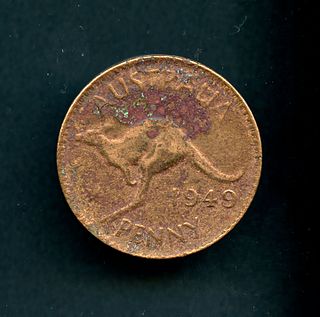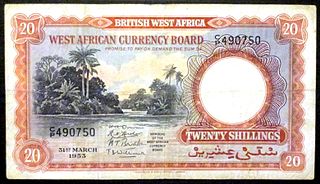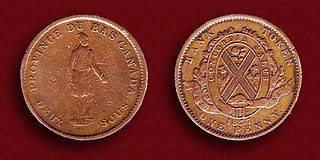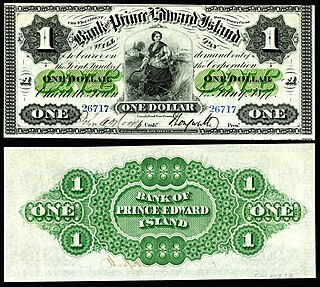The British West Indies dollar (BWI$) was the currency of British Guiana and the Eastern Caribbean territories of the British West Indies from 1949 to 1965, when it was largely replaced by the East Caribbean dollar, and was one of the currencies used in Jamaica from 1954 to 1964. The monetary policy of the currency was overseen by the British Caribbean Currency Board (BCCB). The British West Indies dollar was never used in British Honduras, the Cayman Islands, the Turks and Caicos Islands, the Bahamas, or Bermuda.
The leone is the currency of Sierra Leone. It is subdivided into 100 cents. The ISO 4217 code is SLL and the leone is abbreviated as Le placed before the amount.

Australian coins refers to the coins which are or were in use as Australian currency. During the early days of the colonies that formed Australia, foreign as well as British currency was used, but in 1910, a decade after federation, Australian coins were introduced. Australia used pounds, shillings and pence until 1966, when it adopted the decimal system with the Australian dollar divided into 100 cents. With the exception of the first Proclamation Coinage and the holey dollars, all Australian coins remain legal tender despite being withdrawn from circulation.

The dollar has been the currency of Liberia since 1943. It was also the country's currency between 1847 and 1907. It is normally abbreviated with the dollar sign $, or alternatively L$ or LD$ to distinguish it from other dollar-denominated currencies. It is divided into 100 cents.

The dollar has been the currency of Barbados since 1935. The present dollar has the ISO 4217 code BBD and is normally abbreviated with the dollar sign "$" or, alternatively, "Bds$" to distinguish it from other dollar-denominated currencies. It is divided into 100 cents.

The British West African Pound was the currency of British West Africa, a group of British colonies, protectorates and mandate territories. It was equal to the pound sterling and was similarly subdivided into 20 shillings, each of 12 pence.

The dollar (R$) was the currency of Rhodesia between 1970 and 1980. It was subdivided into 100 cents.
In 1820, in response to a request from the British colony of Mauritius, the imperial government in London struck silver coins in the denominations of 1⁄4, 1⁄8, and 1⁄16 dollars. The dollar unit in question was equivalent to the Spanish dollar and these fractional coins were known as 'Anchor Dollars' because of the anchor that appeared on them. More of these anchor dollars were struck in 1822 and not only for Mauritius but also for the British West Indies. In addition to this, a 1⁄2 dollar anchor coin was struck for Mauritius. A year or two later, copper dollar fractions were struck for Mauritius, the British West Indies, and Sierra Leone.

The dollar is the currency of the Cook Islands. The dollar is subdivided into 100 cents, although some 50 cent coins carry the denomination as "50 tene".
The daler was the currency of the Danish West Indies between 1849 and 1917, and of the United States Virgin Islands between 1917 and 1934.
The British North Borneo dollar was the currency of British North Borneo from 1882 to 1953. It was subdivided into 100 cents. The dollar had remained at par with the Straits dollar, the currency of Malaya and Singapore, at the value of one dollar to 2 shillings 4 pence sterling from its introduction until both currencies were replaced by the Malaya and British Borneo dollar in 1953. Both coins and banknotes were issued by the British North Borneo Company.

The dollar was the currency of the colony and, later, Dominion of Newfoundland from 1865 until 1949, when Newfoundland became a province of Canada. It was subdivided into 100 cents.
The dollar was the currency of Nova Scotia between 1860 and 1871. It replaced the Nova Scotian pound at a rate of 5 dollars = 1 pound and was consequently worth less than the Canadian dollar. The Nova Scotian dollar was replaced by the Canadian dollar at a rate of 73 Canadian cents = 75 Nova Scotian cents, thus maintaining the difference between the two currencies established in 1860.

The pound was the unit of account for currency of the Canadas until 1858. It was subdivided into 20 shillings (s), each of 12 pence (d). In Lower Canada, the sou was used, worth 1⁄2 penny. Although the pounds, shillings, and pence accounting system had its origins in the British pound sterling, the Canadian pound was never formally linked to the British currency.
The history of currency in the British colony of Dominica closely follows that of the British Eastern Caribbean territories in general. Even though Queen Anne's proclamation of 1704 brought the gold standard to the West Indies, silver pieces of eight continued to form a major portion of the circulating currency right into the latter half of the nineteenth century.
The history of currency in the British colony of Grenada closely follows that of the British Eastern Caribbean territories in general. Even though Queen Anne's proclamation of 1704 brought the gold standard to the West Indies, silver pieces of eight continued to form a major portion of the circulating currency right into the latter half of the nineteenth century.
The dollar was the currency of Penang between 1786 and 1826. It was subdivided into 100 cents, also called pice, and was equal to the Spanish dollar. The dollar was introduced after the East India Company acquired the island in 1786. In 1826, the Indian rupee was declared legal tender in Penang at a value of 48 pice. The dollar again became the currency of Penang with the introduction of the Straits dollar.
The history of currency in the British colony of St. Kitts closely follows that of the British Eastern Caribbean territories in general. Even though Queen Anne's proclamation of 1704 brought the gold standard to the West Indies, silver pieces of eight continued to form a major portion of the circulating currency right into the latter half of the nineteenth century.
Antigua and Barbuda are actually two separate islands which operate as one country. Along with many other countries of the Caribbean, they use the East Caribbean dollar as their official currency, which was first brought into circulation in 1965 to replace the British West Indies dollar.

The Prince Edward Island dollar was a unit of currency used in Prince Edward Island. The dollar replaced the Prince Edward Island pound in 1872 at a rate of 1 pound = 4.866 dollars. The dollar was subdivided into 100 cents.












